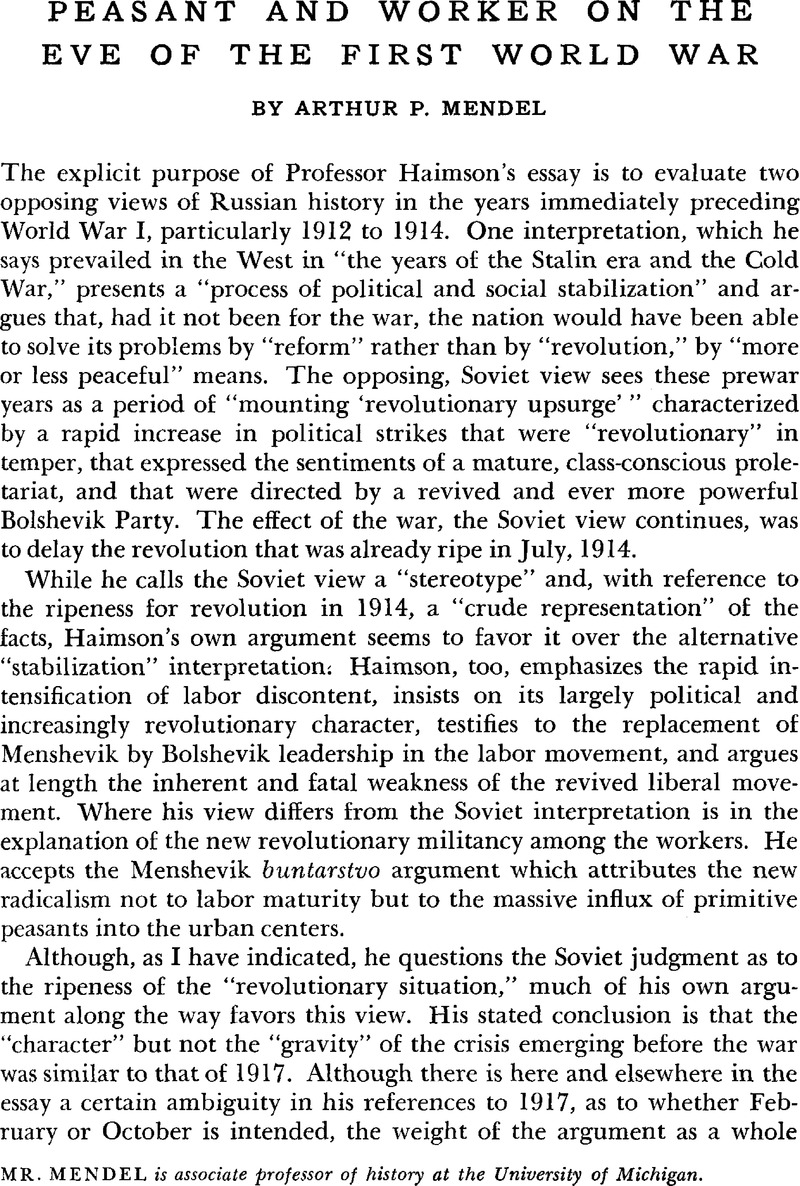Article contents
Peasant and Worker on the Eve of the First World War
Published online by Cambridge University Press: 27 January 2017
Abstract

- Type
- Discussion
- Information
- Copyright
- Copyright © Association for Slavic, East European, and Eurasian Studies. 1965
References
1 Although this is largely guess, Haimson's interpretation seems to represent a merger j of Weidle's theory of profound “cracks” in prerevolutionary Russian society and Trotsky's theory of combined development, the simultaneous development of the “cracks” or “po- I larizations” that elsewhere occurred in sequence. The central issues discussed throughout are also reminiscent of the debate between Miliukov and opponents like Maklakov over the relative advantages and dangers in linking the liberal and the socialist-led labor move- I ments. In his University of Chicago lectures, Miliukov distinguished Russian liberalism from European by arguing that the former, unlike the latter, emerged together with the j socialist movement and had to incorporate socialist goals as well as collaborate with j socialist leaders in order to succeed in the struggle for purely political, liberal goals. One conclusion to be drawn from Haimson's argument is that Maklakov's warning was well grounded: labor under radical leadership would win control of a revolution against tsarism i and sweep aside its erstwhile liberal allies along with tsarist reactionaries.
2 This is the first of a number of places in the essay where Haimson introduces a qualification that does not seem to alter the argument. Other examples of such nonqualifying qualifications, to be discussed below, concern the issue of political strikes, the causes and extent of Bolshevik leadership in the labor movement, the attitude of liberal “society“ toward the labor movement, the question of Lenin's readiness to gamble on revolution in 1914, and the impact of the Stolypin reforms. Although this feature of Haimson's presentation does damage to his basic argument, it is also testimony to his scholarly honesty, his willingness to present the other side of the case.
3 Throughout the essay, the central term “revolution” lacks clarity. What does Martov mean by “overturn,” especially when in the same quotation he warns against “the course of events” being “artificially forced“? If it refers to the end of the Regime of the Third of June, as his fellow Menshevik Dan does when predicting the consequences of the post-Lena “turning point,” then this “revolution” is quite compatible with the goals of the liberals and the interpretation of those whom Haimson sees arguing “stabilization,” “moderation, “ and “tranquillity.“
4 Still, one cannot be sure of this, notwithstanding Haimson's emphasis; for he elsewhere explains the difference between the revolutionary fervor in St. Petersburg and the situation in, for example, the Donbas by the role of Bolshevik leadership in the former.
5 In general, I question Haimson's heavy reliance on Menshevik and even liberal (for example, Kadet) materials for his description of conditions and events. Invaluable as these articles and letters are for revealing the views of their authors, they are hardly disinterested presentations of “realities.”
- 1
- Cited by




